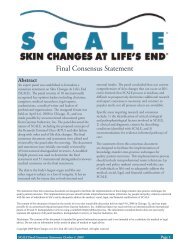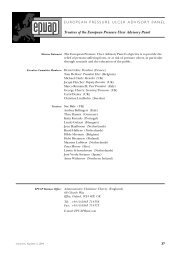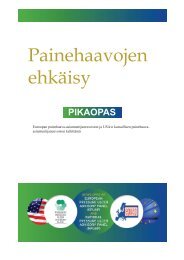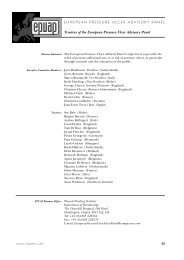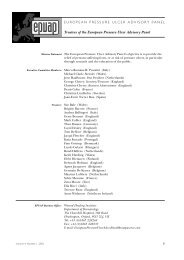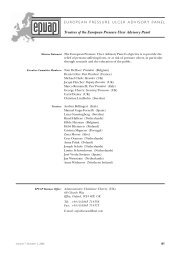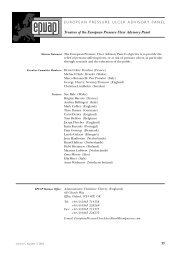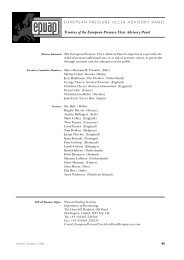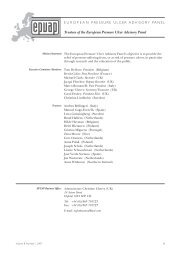EPUAP Review 10.1.indd - European Pressure Ulcer Advisory Panel
EPUAP Review 10.1.indd - European Pressure Ulcer Advisory Panel
EPUAP Review 10.1.indd - European Pressure Ulcer Advisory Panel
Create successful ePaper yourself
Turn your PDF publications into a flip-book with our unique Google optimized e-Paper software.
EUROPEAN PRESSURE ULCER ADVISORY PANEL<br />
6.1. Consider individuals with alterations to intact skin to be at risk of<br />
pressure ulcer development.<br />
Alteration in skin condition include dry skin, erythema and other<br />
alterations. The presence of non-blanching erythema also increases the<br />
risk of further pressure ulcer development.<br />
7. Use a structured approach to risk assessment which is refined by using<br />
clinical judgment informed by knowledge of key risk factors. (Strength<br />
of Evidence = C)<br />
8. Consider the impact of the following risk factors on an individual’s risk<br />
of pressure ulcer development.<br />
a) Nutritional indicators<br />
Nutritional indicators include hemoglobin, anemia, and serum<br />
albumin, measures of nutritional intake, and weight.<br />
b) Factors affecting perfusion and oxygenation<br />
Factors affecting perfusion include diabetes, cardiovascular instability/<br />
nor epinephrine use, low blood pressure, ankle brachial index and<br />
oxygen use.<br />
c) Skin moisture<br />
d) Increased age<br />
9. Consider the potential impact of the following risk factors on an<br />
individual’s risk of pressure ulcer development.<br />
a) Friction and shear (Subscale Braden Scale)<br />
b) Sensory perception (Subscale Braden Scale)<br />
c) General health status<br />
d) Body temperature<br />
10. Conduct a structured risk assessment on admission, and repeat as<br />
regularly and as frequently as required by patient acuity. Reassessment<br />
should also be undertaken if there is any change in patient condition.<br />
(Strength of Evidence = C)<br />
11. Develop and implement a prevention plan when individuals have been<br />
identified as being at risk of pressure ulcer development. (Strength of<br />
Evidence = C)<br />
SKIN ASSESSMENT<br />
1. Ensure that a complete skin assessment is included in the risk assessment<br />
screening policy in place in all health care settings. (Strength of<br />
Evidence = C)<br />
Each health care setting should have a policy in place including recommendations<br />
for the structured approach to skin assessment relevant to<br />
the setting, targeted clinical areas, the timing of assessment and reassessment.<br />
It should have clear recommendations for documentation of<br />
skin assessment and communication to the wider healthcare team.<br />
2. Educate the professional on how to undertake a comprehensive skin<br />
assessment that includes the techniques in identifying blanching<br />
response, localized heat, oedema and induration (hardness). (Strength<br />
of Evidence = B)<br />
These additional assessment techniques can be used for all individuals.<br />
However, there is evidence that Category I pressure ulcers are underdetected<br />
in individuals with darkly pigmented skin because areas of<br />
redness are not as easily seen.<br />
6<br />
Volume 10, Number 1, 2009



